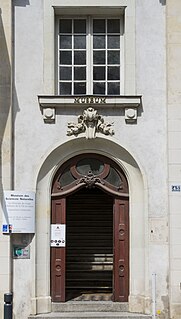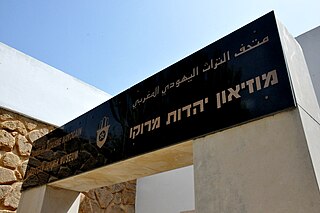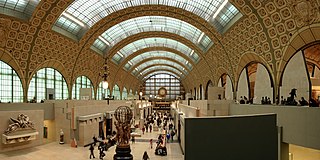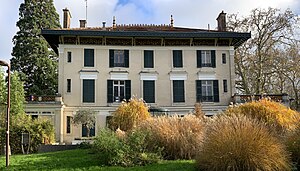
The Louvre, or the Louvre Museum, is the world's most-visited museum, and a historic landmark in Paris, France. It is the home of some of the best-known works of art, including the Mona Lisa and the Venus de Milo. A central landmark of the city, it is located on the Right Bank of the Seine in the city's 1st arrondissement. At any given point in time, approximately 38,000 objects from prehistory to the 21st century are being exhibited over an area of 72,735 square meters. Attendance in 2021 was 2.8 million due to the COVID-19 pandemic, up five percent from 2020, but far below pre-COVID attendance. Nonetheless, the Louvre still topped the list of most-visited art museums in the world in 2021.

The Musée Carnavalet in Paris is dedicated to the history of the city. The museum occupies two neighboring mansions: the Hôtel Carnavalet and the former Hôtel Le Peletier de Saint Fargeau. On the advice of Baron Haussmann, the civil servant who transformed Paris in the latter half of the 19th century, the Hôtel Carnavalet was purchased by the Municipal Council of Paris in 1866; it was opened to the public in 1880. By the latter part of the 20th century, the museum was full to capacity. The Hôtel Le Peletier de Saint Fargeau was annexed to the Carnavalet and opened to the public in 1989.

The Musée du Luxembourg is a museum at 19 rue de Vaugirard in the 6th arrondissement of Paris. Established in 1750, it was initially an art museum located in the east wing of the Luxembourg Palace and in 1818 became the first museum of contemporary art. In 1884 the museum moved into its current building, the former orangery of the Palace. The museum was taken over by the French Ministry of Culture and the French Senate in 2000, when it began to be used for temporary exhibitions, and became part of the Réunion des Musées Nationaux in 2010.

The Musée de l'Orangerie is an art gallery of impressionist and post-impressionist paintings located in the west corner of the Tuileries Gardens next to the Place de la Concorde in Paris. The museum is most famous as the permanent home of eight large Water Lilies murals by Claude Monet, and also contains works by Paul Cézanne, Henri Matisse, Amedeo Modigliani, Pablo Picasso, Pierre-Auguste Renoir, Henri Rousseau, Alfred Sisley, Chaïm Soutine, Maurice Utrillo, and others.

The Muséum des sciences naturelles d'Angers is a municipal museum in Angers. Dedicated to Natural History, the Muséum d'Angers houses in its collections about 530,000 objects, including 3,000 birds, 20,000 shells, 50,000 fossils, 80,000 insects and 350,000 herbarium samples, as well as hundreds of specimens taxidermised or in liquid, skeletons, minerals, technical instruments and Documents. The Muséum d'Angers receives annually about 20,000 visitors, as well as school groups, interns, researchers and volunteers.

The Cité nationale de l'histoire de l'immigration is a museum of immigration history located in the 12th arrondissement of Paris at 293, avenue Daumesnil. The nearest métro station is Porte Dorée. It is open Tuesday through Friday from 10 a.m. to 5:30 p.m. and weekends from 10 a.m. to 7 p.m.; an admission fee of €4.50 is charged.

The Museum of Aquitaine is a collection of objects and documents from the history of Bordeaux and Aquitaine.

The Musée des Archives Nationales, formerly known as the Musée de l'Histoire de France, is a state museum of French history operated by the Archives Nationales. The museum features exhibitions drawn from the collections of the government archives and aims to provide document-based perspective on France’s history and the evolution of French society. It is housed in the Hôtel de Soubise in the Marais neighborhood in the 3rd arrondissement of Paris, France. It was first established under Napoleon III in 1867 with the direction of Léon de Laborde.

The Musée d'Archéologie nationale is a major French archeology museum, covering pre-historic times to the Merovingian period. It is located in the Château de Saint-Germain-en-Laye in the département of Yvelines, about 19 kilometres (12 mi) west of Paris.

The Musée dauphinois, located in Grenoble (France), is dedicated to the ethnography, archaeology, history and society of the former province of the Dauphiné. Situated above the neighbourhood of Saint-Laurent in the listed historic monument of Sainte-Marie d’en-Haut, the Musée dauphinois is an accredited “Musée de France“ and takes part in the Long Night of Museums.

The Musée d’Art et d’Histoire is the largest art museum in Geneva, Switzerland.

Joel Ducorroy is a French artist, born in 1955 and known as a "plate artist".

The Musée de la Révolution française is a departmental museum in the French town of Vizille, 15 kilometres (9.3 mi) south of Grenoble on the Route Napoléon. It is the only museum in the world dedicated to the French Revolution.

Laurent Gervereau is a French artist, novelist, philosopher and filmmaker. The founder of the discipline of Visual History, he has devoted his professional life to the world of images, as well as to the direction of cultural and international institutions.
Paris Musées is a public institution that has incorporated in the same entity the 14 City of Paris Museums plus staff in charge of management, collection monitoring and production of exhibitions, events and editions, bringing together about 1000 employees. The headquarters are at the following address: 27 rue des Petites Ecuries, 75 010 Paris.

The Museum of Moroccan Judaism is a museum of Jewish life in Morocco in Casablanca, Morocco.

The 136 museums in the city of Paris display many historical, scientific, and archeological artifacts from around the world, covering diverse and unique topics including fashion, theater, sports, cosmetics, and the culinary arts.

Max Lingner was a German painter, graphic artist, communist, and resistance fighter against the Nazi regime.

The Musée de l'Histoire de France is a museum that was created by King Louis Philippe I in the Palace of Versailles and opened in 1837. At the time, it represented an ambitious project of national reconciliation between the hitherto competing narratives of the French monarchy and the French Revolution, to which Louis-Philippe devoted significant personal attention. Whereas it gradually faded in importance as a museum in the later 19th century, its lavish historicist decoration remains a major exemplar of the art of France's July Monarchy.



















